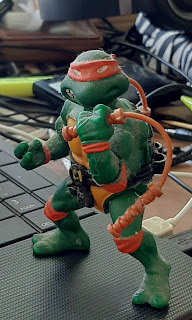The Broken Stick
Much of my childhood was spent playing Ninja.
With the television as the authority of what Ninjas did and what weapons they used I have deemed the Nunchaku the most essential part of my arsenal.
When I got my hands on martial arts books, however, I found that the Nunchaku and the Ninja did not have any connection whatsoever. I have learnt that the Nunchaku rather shared its history with Karate on the Ryukyu Islands of which Okinawa is the capital.
I still loved the weapon regardless of this revelation.
Now... like many Kobudo and Kobujutsu students and people who have gotten their information from the same sources as I would tell you that this weapon was originally a farm implement. I had no reason to doubt this story, but I was to learn a new story long after I had finished high school.
You see... Some people swore that this flail weapon was used by Ryukyu farmers to beat rice grains off the stalks. To this day I wonder whether it is the most efficient way to do that...
Others speculated that night watchmen banged the two sticks together to sound the alarm when fires broke out or the village was under attack.
If anyone has historical accounts of Nunchaku being used in either of the above ways they are welcome to share it with me in the comment sections of the platforms of which I share this post.
The story that had my head bursting with effort to reconcile it with the "facts" that I had gathered in my younger years first came to me from my boss at the time, the late Mrs Ku.
She saw a photo and just said it was "Songjiekun".
Now- I thought I was smart and I thought I heard her say "Sanjiekun" which is the three-section staff in classical Chinese weaponry (Incidentally- Jesse Enkamp has shown me that this weapon is also part of the classical Okinawan arsenal. In Okinawa it is known as the "Sansetsukon. Both Chinese and Okinawan terms mean "threefold joined staff".)
So- I knew that "san" means "three". Now what did "Song" mean...?
The answer eventually came after reading Wong Kiew Kit's book on Shaolin Kungfu. The word "Song" refers to the Emperor of China's Song Dynasty that existed during the first millenium after Christ.
The story goes that the Emperor's staff had broken during a battle and that he- instead of parting with his beloved weapon- joined the pieces together with chain.
Earlier joined staves were much bigger than the small sweepers that we see nowadays.
China's turbulent history of street fights amongst Triads and political factions featured this weapon becoming smaller to be easier to carry and conceal.
In spite of what television and movies show I do not like to lock weapons during a fight. Much less with this weapon. It simply does not function ideally in clinch situations. Those bludgeoning swipes need room to build up power. So- I tend to avoid contact with my opponent's weapon.
Well... seeing that I have made a new blog post about one of my weapons- how about the others?
Join me next week to see which weapon I write about next. :)






双截棍(pronounced shuang jie gun) means double joined stick.
ReplyDelete